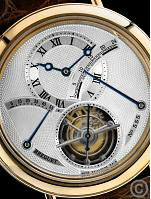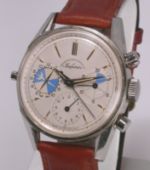-
gliorologi.
User deleted
mi ricorda un altro modello..... . -
Grifone66.
User deleted
CITAZIONE (gliorologi @ 14/1/2009, 10:55)mi ricorda un altro modello.....
certo... questo è evidente...

volevo però andare oltre a suo "simile" by Patek... e capire di più sulla Maison e sul Movimento !!!
Altre info: www.vogard.com/documents/montrespassion0604.pdf
Louis Cottier : Inventeur de la montre à heure universelle
Il faudra attendre 1931 pour que le projet de montre (de poche) à heure universelle voit le jour. Avec le développement des lignes aériennes, le besoin se faisait sentir et il revient à un horloger genevois d'avoir inventé la montre à heure universelle. Le système Cottier est encore largement utilisé aujourd'hui.
A l'époque le succès est immédiat auprès des grandes marques telles Patek, Vacheron Constantin... qui passe commande de montres à heure universelle auprès de l'inventeur. Celui-ci était un horloger indépendant particulièrement réputé (Par exemple, on sait que Hans Wilsdorf, le fondateur de Rolex lui confiait l'entretien de sa collection de montres anciennes). Son invention va révolutionner la lecture de l'heure pour les grands voyageurs.


Edited by Grifone66 - 23/9/2010, 09:13. -
aemilius2.
User deleted
Stupendo! . -
gliorologi.
User deleted
CITAZIONE (Grifone66 @ 14/1/2009, 10:56)CITAZIONE (gliorologi @ 14/1/2009, 10:55)mi ricorda un altro modello.....
certo... questo è evidente...

volevo però andare oltre a Patek... e capire di più sulla Maison e sul Movimento
personalmente non ne ho mai sentito parlare..... -
Grifone66.
User deleted
CITAZIONE (gliorologi @ 14/1/2009, 11:20)personalmente non ne ho mai sentito parlare....
We are sure many of you are confused by the title of this post, as you probably have never heard the names "Agassiz" or "Cottier" before. That is fine, but our goal here at Hodinkee is to not only entertain, but to educate, so here we go.
Louis Cottier was a master of making watches, but most importantly, world time watches (pieces that allow you to tell the time in many different cities at once). He was contracted to build them for a few small brands you may or may not be familiar with, brands like Vacheron Contstantin, Patek Philippe, and Rolex. In fact, he invented the very first two-crowned world time watch for Patek in 1950. This watch is one of the most sought after pieces in the world to this day.
That is all well and good, but what is "Agassiz" and how do they fit into the picture? Well actually, a man by the name of Auguste Agassiz is credited with launching the Longines brand back in the mid 1800s, as well as starting his own eponymously named brand. The direct relationship between Longines and the Agassiz brand has never been clear, but you will see some co-branded pieces out there.
Agassiz did, however, employ Mr. Cottier to build them a world-timer, but not just any world-timer. This watch, at the request of some well to-do Geneva residents, was to be given to the leaders of the Allied Forces of the Second World War as a note of appreciation. We areModern Day Patek Philippe World Timers With Clear Cottier Influence talking about Presidents Harry Truman and Charles De Gaulle, Prime Minister Winston Churchill, and "leader" Joseph Stalin. This took place in the year 1946.
In 1945, Agassiz (by way of Cottier) produced the world-timer we have found for you today. It is in 14K yellow gold, is sized at 32mm, features a moveable inner world-time ring, and is 100% original. It is being sold for $27,500. Considering the fact that Cottier made only 455 world time movements in his lifetime, and roughly 1% of them went to world-leaders, we are confident in saying this is a fair price.
It really is amazing to see how similar this Agassiz watch is to even today's Patek World Time watch (one of our personal favorites), the hour hand especially. They are practically identical.
This is a great opportunity to buy a truly legendary piece from one of the most celebrated and influential watchmakers to ever live.
Fonte: http://www.hodinkee.com/blog/2008/12/12/ag...hill-truma.html
 .
. -
bubba48.
User deleted
Se può essere di aiuto
Those who know something about watches inevitably link the name Agassiz with that of
Longines... and not without reason. The establishment of the Agassiz Watch Co. goes
back to Georges Agassiz in 1876. He was a son of Auguste Agassiz, the founder of the
eponymous watch dealership that later became the Longines watch factory.
When Auguste's nephew, Ernest Francillon established Les Longines in Saint-lmier in
1866, Georges Agassiz was part of the project.
A year later Agassiz crossed the pond to the United States to market Longines timepieces
there. After he returned, he assumed the role of financial and marketing manager at
Longines. In 1876, as business was going extremely badly with his employer, he became.
independent, trading as the Agassiz Watch Co. His corporate mission was to finish and
assemble movements of high value and quality as well as complete watches. After the
introduction of new Swiss trademark laws for watch movements and cases, he created his
own logo - an oval with the signature Agassiz accompanied by a fish. He apparently
realized his most ambitious goals, for in 1889 the Jury of the Paris World exhibition
awarded the manufacturer a gold medal for its remarkably fine movements. In 1896, the
rights to the name passed to Auguste Sandoz of Saint-lmier, and with themthe Agassiz
fish logo.
After the turn of the century, Agassiz started production of jewelry wristwatches. In
addition, the collection comprised chronographs and pocket-watches - among - them
timepieces with ultra-flat movements. Advertisements dated 1925 expressed the view that
Agassiz was also something of an expert in the supply of complicated timepieces, notably
pocket-watches with repeating work. Apart from these, the business produced ringwatches,
officially tested chronometers, eight-day and cockpit clocks. In the 1940s, World
Time watches joined the collection. To all appearances, links with the Longines company
were never entirely severed. The business across the Atlantic, for example, remained in
the same hands for several years, and many watches similarly bore a double signature.. -
.
Orologio e movimento straordinari.
Daniele. -
.
Il codice sul ponte del bilanciere, AXA, corrisponde all'importatore Wittnauer. Come noto era il rappresentate negli Stati Uniti di Longines. . -
pendolettechepassione.
User deleted
Grazie Grifo per tutte le informazioni che ci fornisci, effettivamente è grazie a Louis Cottier se abbiamo il sistema "world time" a fuso orario sempre leggibile, diverso dal sistema a ghiera girevole, in quanto consente la visione istantanea dei vari fusi. . -
Grifone66.
User deleted
Louis Cottier produced four world time dress watches for Agassiz in 1946 with gold and enamel-decorated cases. They were presented to Winston Churcill, President Harry Truman, Joseph Stalin and General De Gaulle
altro esemplare, oro 14K, in vendita per 27.000 $

particolare lato corona .
. -
Grifone66.
User deleted
CITAZIONE (gliorologi @ 14/1/2009, 10:55)mi ricorda un altro modello.....
Il sistema "World Time" utilizzato da Patek Philippe fu inventato intorno al 1935 da Louis Cottier (1894-1966), famoso orologiaio indipendente ginevrino autore di un gran numero di orologi complicati realizzati anche per altre importanti Case orologiere quali Agassiz, Vacheron Constantin e Rolex (si stima che egli abbia realizzato complessivamente 455 movimenti World Time destinati sia a orologi da polso che a modelli da tasca e da tavolo).
Tra i primissimi modelli Patek Philippe figura un orologio con cassa rettangolare galbé in oro rosa del 1937, Ref. 515, di cui si conoscono soltanto due esemplari.
Tra il 1937 e il 1940 il movimento "world time" fu montato su diversi tipi di casse, in base alle quali si distinguono le diverse referenze: nello specifico, la Ref. 542 HU, di 28 millimetri di diametro, con grandi anse dritte e lunetta con i nomi di 30 città, e la Ref. 96 HU, con cassa Calatrava, della quale si conosce un unico esemplare datato 1939.
Intorno al 1939-40 iniziò la produzione delle serie 1415 e 1416, entrambe caratterizzate da una cassa rotonda di 31 millimetri di diametro e dalla lunetta girevole con i nomi delle principali città del mondo; diverse, nei due casi, le anse: a goccia per la Ref. 1415 e dritte a uncino per la Ref. 1416.
Nel 1940 fu realizzato, su richiesta del dottor P. Schmidt, un esemplare unico di cronografo con le ore del mondo (Ref. 1415-1), cassa in oro giallo con pulsanti rettangolari, lunetta con 33 città, quadrante con duplice scala per le pulsazioni e la pressione; tale orologio è stato venduto da Antiquorum nell'asta di Ginevra del 15 e 16 ottobre 1994 per la straordinaria cifra di 990.000 franchi svizzeri.
A partire dagli anni '40, gli orologi a ore universali di Patek Philippe possono essere raggruppati in tre serie principali: una serie di orologi da tasca, alcuni con quadrante argenté o nero, altri con quadrante in smalto cloisonné (Ref. 605, in produzione dagli anni '40 agli anni '60); due serie di orologi da polso, rispettivamente con una corona (Ref. 1415, in produzione dal 1939 agli anni '50) e con due corone (Ref. 2523 e 2523-1, in produzione dal 1953 al 1965 circa), alcuni con quadrante argentato o dorato, altri con quadrante guilloché, altri ancora con quadrante in smalto o in smalto cloisonné. Soprattutto questi ultimi, disponibili con la mappa di Europa, Asia e Africa, o del nuovo continente, sono quelli maggiormente apprezzati dai collezionisti. Sono stati loro, con le eccezionali vendite degli anni '90, a creare un clima di grande interesse intorno a questa tipologia di orologi, preparando il terreno per il lancio della generazione moderna dei modelli World Time di Patek Philippe: la Ref. 5110 del 2000, seguita e sostituita, nel 2006, dalla Ref. 5130.
.
Modello a Ore Universali con cassa rettangolare galbé, Ref. 515 realizzata nel 1937 (Patek Philippe Museum)
La Ref. 542 HU, del 1937. Con il suo diametro di soli 28 millimetri, rappresenta il più piccolo orologio a ore universali (Patek Philippe Museum).
La Ref. 1415 1, Cronografo a Ore universali realizzato nel 1940 su richiesta specifica di un cliente (esemplare unico, Patek Philippe Museum).
Ref. 2523 del 1953, con cassa in oro rosa a 2 corone e quadrante in smalto traslucido.
La Ref. 2523/1, in produzione dal 1953 al 1965 circa (Patek Philippe Museum)
Orologio da tasca Ref. 605, in produzione tra il 1940 e il 1960 (Patek Philippe Museum).
La Ref. 5110, presentata nel 2000. Dallo scorso anno è stata sostituita dalla Ref. 5130, con cassa di maggiore diametro.
Edited by Grifone66 - 21/1/2009, 10:39. -
.
perchè non si vede mai la seconda coroncina di regolazione? . -
britishshortair.
User deleted
Posto un esempio della qualità Agassiz , una manifattura dedicata interamente a prodotti di grande pregio , eccone un esempio.
Grazie Grifone per l'ottimo ed interessante topic , solo con 3hd del genere la sezione può crescere facendo conoscere a tutti i forumisti la storia dell'orologeria e delle varie maison.
Preso dalla baia tempo fa....Attached Image. -
britishshortair.
User deleted
........ Attached Image.
Agassiz by Louis Cottier dal "World Time ai WWII... |










 Instagram
Instagram Facebook
Facebook YouTube
YouTube Iscritti
Iscritti